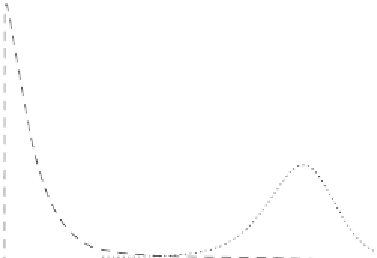Environmental Engineering Reference
In-Depth Information
p
s
10
______
a
0.03
b
0.50
8
............
a
0.03
b
0.60
____
a
0.03
b
0.30
6
4
2
s
0.2
0.4
0.6
0.8
1
Figure 4.19. Probability distribution of soil moisture calculated with different param-
eters of the feedback function
bs
. The bimodal behavior disappears when
the sensitivity of storm frequency to soil moisture (i.e., the parameter
b
) is either
too weak (dashed curve) or too strong (dotted curve); in intermediate conditions the
probability distribution has a well-defined bimodality. The soil parameters are typical
of loamy sand (
s
h
=
λ
=
a
+
11,
s
∗
=
0
.
06,
s
w
=
0
.
0
.
28,
s
fc
=
0
.
31,
β
=
12
.
76,
n
=
0
.
44,
0md
−
1
). The other parameters are
E
max
=
5md
−
1
,
E
w
=
05 m d
−
1
,
K
s
=
2
.
2
.
0
.
α
=
11
.
0 mm/storm,
Z
r
=
50 cm (after
D'Odorico and Porporato
,
2004
).
In the absence of feedback between soil moisture and precipitation, the probability
distribution of soil moisture is typically unimodal. Positive feedbacks between soil
moisture and precipitation (e.g.,
Brubaker and Entekhabi
,
1995
;
Findell and Eltahir
,
1997
,
2003
;
Alfieri et al.
,
2008
) can occur during the growing season at midlow
latitudes. These feedbacks have been found to affect more the number of storms in
the growing season (i.e., the parameter
λ
) than their magnitude (i.e., the mean storm
depth
), as shown in Fig.
4.18
for the case of Illinois. Thus the occurrence of soil-
moisture-precipitation feedbacks translates into a state dependency in the parameter
λ
α
, which, in turn, has been shown to lead to the emergence of bimodality in
p
(
s
)
under certain combinations of soil, plant, and climate conditions (
Rodriguez-Iturbe
et al.
,
1991
;
D'Odorico and Porporato
,
2004
). Thus soil-moisture-precipitation feed-
backs could cause the emergence of two preferential states in summer soil-moisture
dynamics. Higher (lower) soil-water contents would be associated with higher (lower)
probabilities of rainfall occurrence, which would keep the system locked - for a rel-
atively long fraction of the warm season - in a wet (dry) state. The effect of noise
(i.e., randomness of precipitation) on these dynamics is to cause transitions between
these two preferential states, whereas intermediate conditions would correspond to
unstable states with the lowest probability of occurrence (
D'Odorico and Porporato
,
2004
).
Figure
4.19
shows some examples of probability distributions of soil moisture cal-
culated for a loamy sand soil by use of different parameters for the feedback function




















Search WWH ::

Custom Search